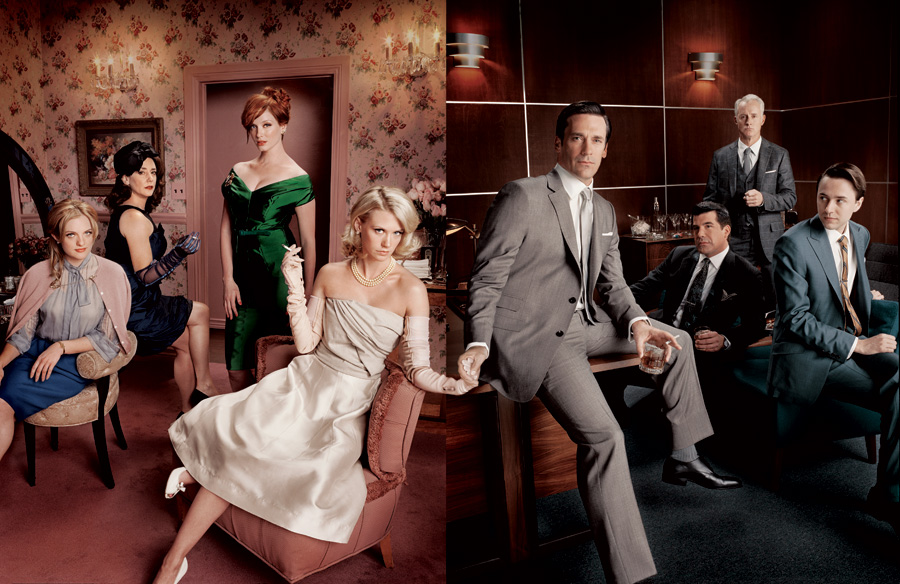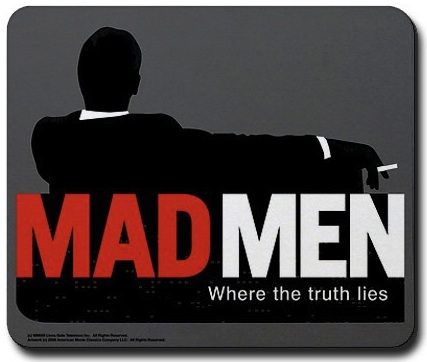Why journalists love "Mad Men" and not religion news
 What does the "Mad Men" fad have to do with religion news and religion writing? Hang on, we'll get to that. I promise.
What does the "Mad Men" fad have to do with religion news and religion writing? Hang on, we'll get to that. I promise.
But first things first. I have been fascinated with the religion beat ever since I was in college, when I discovered that -- even at Baylor University, the world's largest Baptist university -- most of my journalism colleagues simply were not interested in writing news stories about religion.
Oh, everyone wanted to write opinion pieces about religious subjects -- but not news. Everyone wanted to write edgy columns focusing on the many ways that our university was wrong, but no one wanted to interview people on both sides of the tough issues and then write balanced stories that attempted to chart the debates.
However, my mentor -- the famous Texas journalist David McHam -- once pulled me aside (after a particularly troubling episode of the student newspaper ignoring a valid religion-news story) and said something that changed my life.
McHam noted, and I promise you this quote is accurate: "I think religion is the worst covered subject in journalism. Do you want to try to do something about that?"
I did. So he introduced me to religion reporter Louis Moore, then of The Houston Chronicle, who was an officer in the Religion Newswriters Association. I started learning everything I could about religion writing and, here's the key, that included asking people about all the reasons journalists offered for ignoring religion news and the role that religious faith plays in real life in America and around the world. Yes, we're talking about "ghosts" and "blind spots."
This leads me to the spring of 1982 and some research I did in graduate school -- 30 years ago, obviously. An interview way back then provided a hook for my syndicated column this week, which marked the 24th anniversary of the birth of my "On Religion" feature for Scripps Howard News Service. Here's the top:
The late, great Associated Press religion reporter George Cornell noticed a striking pattern as he dug into a 1981 survey of journalists in elite newsrooms such as The New York Times, The Washington Post, The Wall Street Journal, Time, Newsweek, ABC, CBS and NBC.
In the space marked "religion," 50 percent of these elite journalists wrote one word -- "none."
"They wrote 'none' and many even underlined that word," said Cornell, in an interview conducted for my graduate project at the University of Illinois in Urbana-Champaign. Parts of the interview were included in my 1983 cover story on religion-news coverage for The Quill, the journal of the Society of Professional Journalists.
In the religion slot, he noted, they "didn't just say 'none.' They said 'NONE.' "
Other numbers jumped out of that controversial report by researchers S. Robert Lichter and Stanley Rothman, such as the fact that 8 percent of the journalists said they attended worship services weekly, while 86 percent said they seldom or never did so. In contrast, the Gallup Organization has consistently reported that about 40 percent of Americans claim to attend services each week.
Now, ever since that piece in The Quill, I have been listening to people argue about this question: Why do so many of the people who manage mainstream newsrooms refuse to take religion news seriously?
Of course, there are plenty of religious believers who simply assume that journalists hate religious believers -- especially traditional believers.
That's too simplistic. You can just as easily point a finger of blame at religious schools for failing to produce journalists with the skills needed to work in the mainstream press.
As I have said a million times, the religion-beat wars are linked to a "blind side" that has two sides. The bottom line: The two halves of the First Amendment just don't get along. Far too many religious people simply do not respect the valid role that the press plays in a free society and far too many journalists do not respect the role that religious institutions play in that same free society.
I could go on and on. But before I get to "Mad Men," you might want to look at this classic 2007 PressThink essay by Jay Rosen entitled "Journalism is Itself a Religion." It contains a key question: The press may, by its nature, doubt claims of eternal truth. However, does this inborn skepticism require journalists to poorly cover the views of people who do believe in eternal, transcendent truths? In other words, is it tolerant to be intolerant (thus producing unbalanced often inaccurate news coverage) when dealing with true believers that you believe are intolerant?
Like I said, I have heard so, so, so many theories on why religion news gets so little institutional respect in the Fourth Estate.
Then, earlier today, one of my best friends -- Rod "Crunchy Cons" Dreher -- came up with an interesting new spin on this issue. His blog piece, which is full of interesting twists and turns (movie reviewing, "craft" beers, suburban news bureaus as visions of hell, etc.), is called "The 'Who Watches Mad Men?' Effect."
You need to read the whole crazy thing, which focuses on why journalists tend to become so entranced with items in elite culture and pop culture (think "Mad Men") that are simply not that relevant to, well, most of the people who once read daily newspapers.
“Mad Men” was, at least for a while, a really innovative, interesting drama (it may still be, I dunno). It’s relative lack of popularity may say very little about its quality, and quite a lot about the limits of mass consumer taste. Fifty skrillion more people drink Budweiser than drink craft beers. All the interesting stuff in American beermaking is happening at the craft level. What is there to say about Budweiser?
You get the point. And yet, I wonder about this same dynamic applied to the coverage of religion in America. Unlike the arts, fine dining, beermaking, etc., religion is not about connoisseurship and innovation. Yet if one follows the mainstream media’s coverage of religion, one generally sees a disproportionate amount of attention paid to the kinds of religion stories that are conventionally interesting than to the kind of religion stories that reflect how many, even most, religious Americans live. The Episcopal Church, for example, is the “Mad Men” of American religion. Slightly more people watch “Mad Men” on a given week than belong to the Episcopal Church, which has about 2 million members, and steadily falling. There are vastly more people in suburban megachurches on a given Sunday than in Episcopal parishes. Yet who gets the media attention? Part of this is because TEC really is and has been at the forefront of a huge religion story: the way churches are splitting on the subject of homosexuality. What was pretty much only an Episcopal phenomenon 15 or 20 years ago is now unquestionably mainstream.
My guess, though, is that the disproportionate press attention paid to TEC’s Sturm and Drang has as much to do with what interests the people in newsrooms who decide what’s news. Newsrooms, as has been firmly established, are highly secular places. They are also places where one’s progressive bona fides are not established by one’s position on economic issues, but on culture-war issues, especially on sexuality. This is why the pope can talk all day long about the poor, or about peacemaking, and the US press is ho-hum about it. But let him say something about sex, and it’s stop-the-presses time.
Anyway, I’m generalizing, but it’s still interesting to think about why certain things, and certain issues, get covered by the media, and others don’t.
In other words, religion -- especially in its traditional forms -- is simply not cool to the kinds of young-ish, urban, secular and/or "spiritual but not religion" people who tend to populate newsrooms (or even urbane Baby Boomers such as former New York Times editor Bill Keller).
This brings me to one final point, one troubling juxtaposition of religion-beat statistics that caught my eye the other day when I was following up on Sarah Pulliam's post about the new religion-news study (.pdf is here) from the University of Southern California and The University of Akron.
Thus, here is the end of this week's Scripps Howard column:
In this survey, nearly 60 percent of the journalists said they think "religious people are far too sensitive about religion stories." At the same time, a sizable minority of news consumers -- 37 percent -- remain convinced that journalists are "hostile to religion and religious people."
Wait a minute. That 37 percent figure is uncomfortably similar to the consistent Gallup finding (the previously mentioned 40 percent) on the number of Americans who claim to attend weekly worship services. Is there a connection?
This correlation is relevant, but these groups "do not overlap completely," said veteran religion-news researcher John C. Green of Akron.
Nevertheless, he said, "there is a connection between regular worship attendance and the perception that the news media are hostile to religious people." At the same time, "less-religious journalists are more likely to agree that religious people are too sensitive."
The standoff continues. It's kind of like deja vu all over again.
Cheers. Sorry for rambling about a bit. There is so much I could say on this topic after 30-plus years on the front lines.
NOTE: Please focus your comments on the key issues: Why do so many mainstream newsrooms (many, but not all) struggle to cover religion news in an accurate and balanced manner? Why is religion so hard to "get"?
